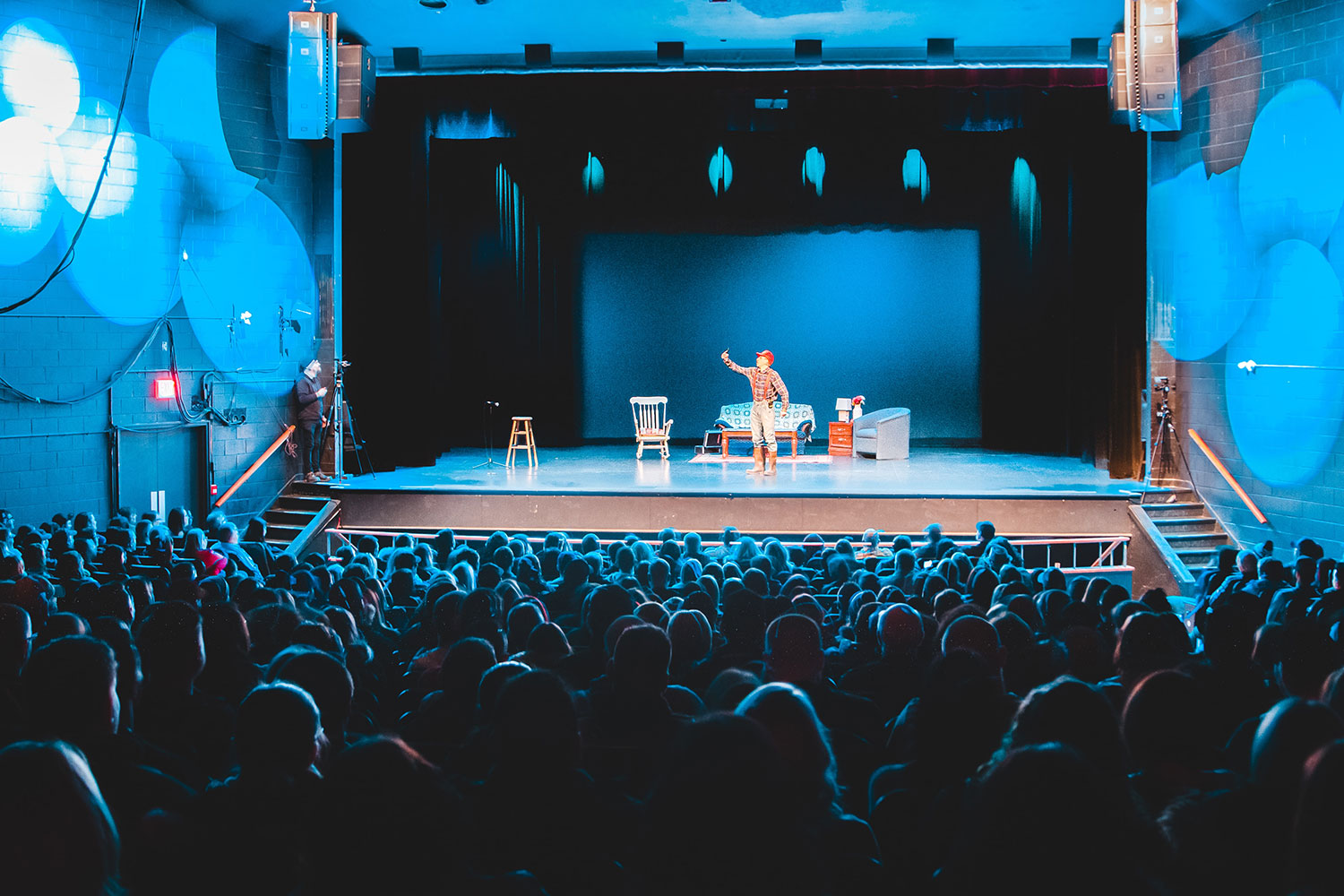Survival Strategies for the Arts
John Killacky explores how the arts can survive and thrive — even as civil society changes, and health and human service needs rise.

Almost everyone agrees funding problems will become more acute in the upcoming three to five years.
The arts are where hope lives. And right now, as the very tenets of civil society are being re-written, and as health and human service needs rise, there is legitimate concern about whether the arts will survive, how the arts can thrive.
The arts, like every other nonprofit sub-sector, are being challenged by significant contribution losses from government, corporations, foundations, and private donors. Box office and gallery admissions are also eroding as discretionary dollars evaporate. Almost everyone agrees funding problems will become more acute in the upcoming three to five years. Adaptability is replacing growth as a barometer of success.
There’s no question to me but that the arts organizations that have dynamic, interactive, authentic relationships with their constituents, audiences, and neighbors are the ones that will come out of this maelstrom stronger. Here are ten ideas for organizations and a potpourri of options for audience members.
1. Do more with less by doing something different.
Groups are mounting four plays instead of six, sharing co-production costs, presenting biannual seasons instead of annual, shortening performance runs, mining permanent collections, and altering gallery hours to allow for higher production values, deeper engagement, and higher audience satisfaction. Capitalize to mission delivery, not sustainability. Michael Kaiser from the Kennedy Center is adamant: “We mustn’t be scared into thinking smaller. Small thinking begets smaller revenue that begets smaller institutions and reduces excitement and involvement.”
2. Place matters.
Make sure the neighborhood feels your building is their community center or assembly hall. I loved when Yerba Buena Center for the Arts hosted an election night party last November — a wonderful cultural celebration.
When I go to the theatre I ask myself: why is this theatre presenting this piece at this time in this community? Through your marketing materials, your programs, your audience involvement, make sure your audience can answer that question. Audiences will respond when they know why you are presenting a particular play/exhibit/dance. Eric Chinski of Farrar, Straus, & Giroux offers a potent reminder of relevance: “The word necessary comes to mind for me. Beyond a good story, beyond good writing, does the novel feel necessary?”
3. Invite the public in.
Expand gallery labels. Dramaturgical notes are needed in every discipline. Pre-concert talks frame and empower audiences. Cultural contextualization translates, bridges, and illuminates artistic expression for both the cognoscenti and the general public. Visual artist provocateur Marcel Duchamp got it: “The closer the ratio is of what the artist sees versus what the audience thinks they see, the greater the artist.
Be transparent and frank about challenges. Ask for help. When the New York Times ran an item on the financial plight of San Francisco’s Magic Theatre, an anonymous benefactor from Manhattan (with no previous history of support) stepped up with a major gift.
4. Let audiences co-author meaning: experiment with social media.
Link young professionals into your company’s social networks. Trendies can then see who is attending opening night, at intermission tweet friends on how fabulous and sexy the new dance is, and do a post-mortem chat on Skype with the artistic director. Find genuine ways for audiences to contribute and find meaning — before, during, and after events. Try something small and see how it goes; find what’s right you’re your organization. Arts consultant Holly Sidford reminds us, “Participation is the most important renewable resource.”
5. The middle class can save the arts.
Consistently, 75% of private donations come from individuals and another 7% from bequests (GivingUSA). Religion garners one-third of this largess; arts, culture, and the humanities only receive 4%. None of us minds tithing to our mosque, temple, synagogue, or church. In the arts, we too offer transformational experiences, so let’s operationalize the “church ask.” Start with the people you know: audiences, volunteers, donors, and neighbors — and ask for modest gifts, often. The Obama campaign proved the power of this kind of fundraising.
Does this mean passing the plate in the audience? Well, why not? Keith Hennessy has a free night in every run of his Circo Zero troupe, where the audience is thanked for coming and then asked to pay what they can. He reports contributions on free nights are higher than the usual box office per night.
6. Support the little league players.
Sports teams know that the first sport we play is the one we follow — that’s why little leagues are integral to professional sports marketing. Arts researcher Alan Brown found 74% of orchestra subscribers sing or play an instrument. Similar correlations exist in dance, visual art, and theater. His conclusion: “Supporting personal practice is audience development.”
Dance and theater companies that have schools guarantee a built in audience, as well as diversified income. Further, The Nutcracker and other holiday staples prove putting kids on stage is good for business. Getting back to the sports analogy, open rehearsals including informal meet and greets with artists are like pre-game warm-ups and autographs: they connect the amateur practitioners with the highest version of the art.
7. The First Global Generation.
Pollster John Zogby finds Americans adjusting to the economic realities by “living with less, embracing diversity, looking inward, and demanding authenticity.” These meta-movements are shared equally by Baby Boomers and what he calls the First Global Generation of 18 to 29 year olds.
Both generations are looking for meaningful experiences. They don’t want to be told everything is “extraordinary;” but they do want to know what they will encounter and how they might feel. The arts community is perfectly situated to appeal to these roving bands of “secular spiritualists,” but needs to speak directly without hyperbole.
8. Risk failing.
Nonprofit arts organizations are not supposed to be commercial presenters; they are meant to provide genuine alternatives. As the sector looks to increase earned income, both mission drift and diluted impact are concerns. Commercial entertainment does not do very well chasing after blockbusters. Under-capitalized nonprofits will never be able to compete, so let’s not try. Arts organizations need to be counter-intuitive in their offerings, truly providing alternatives in our community. Samuel Beckett’s words from Worstward Ho are apt: “Ever tried. Ever failed. No matter. Try Again. Fail again. Fail better.”
9. Have the Conversation.
Small businesses seldom survive decade after decade. Do you still have a unique and necessary role in the cultural ecosystem? Imagine strategic partnerships, joint ventures, and back office collaborations to improve economy of scale, as well as efficacy of program and service delivery. Merger, consolidation, and sunsetting should also be examined. A rigorous analysis of internal strengths and weaknesses and external opportunities and threats is called for.
10. Become a cultural citizen.
Playwright Tony Kushner tells us, “When you don’t act, you act; when you don’t vote, you vote.” Demand all politicians have an arts platform. Support only those that do. Hold house parties for arts friendly politicos. Invite them to openings and receptions and let them be noticed. When over 200 artists showed up in Oakland’s City Hall to protest the proposed elimination the arts budget, City Council had no choice other than to reinstate. And better yet, run for school board to ensure arts are in every school, every day for every child. Claim your cultural agency.
P.S. Things audiences can do (and all of us are audience members).
Go to Open Studios and buy art. Attend theater. Donate. Take salsa or tango lessons. Enjoy dance performances. Bring a friend. Donate. Sing with a chorus. Listen to live music. Donate. Write a poem, short story, or memoir. Buy a local author’s book. Make art with your kids at home and at a museum’s family day. Participate. Donate. Debate the merits of an independent film and then upload your own onto YouTube. Have a bake sale to support an artist residency in a nearby school. Host a season announcement, Tupperware-style, for friends. Commission an artist to commemorate a birthday or anniversary. When you love something, tell your friends. Word of mouth remains the best box office motivator.
See also:
- Thinking the Unthinkable: Maybe We Should Shut Down
- Closing Down the Right Way
- Nonprofit Layoffs and Furloughs: Do Them Right
- Loans from Nonprofit Board Members
About the Author
John R. Killacky left the San Francisco Foundation in June 2010 to become the executive director of Flynn Center for the Performing Arts in Burlington, Vermont. He is former executive director of the Yerba Buena Center for the Arts (San Francisco) and former performing arts curator of the Walker Art Center (Minneapolis). He is shown here with Shetland pony Pacific Raindrop.
Thanks to the Flynn Center for the collage of artists, the photo of the Mingus Ensemble, and for their season schedule cover.
Articles on Blue Avocado do not provide legal representation or legal advice and should not be used as a substitute for advice or legal counsel. Blue Avocado provides space for the nonprofit sector to express new ideas. Views represented in Blue Avocado do not necessarily express the opinion of the publication or its publisher.












John, great food for thought! FYI, the Beckett piece is "Worstward Ho."
Cheers!
Rick Stein
Executive Director
Arts Orange County
John, great food for thought! FYI, the Beckett piece is "Worstward Ho."
Cheers!
Rick Stein
Executive Director
Arts Orange County
John,
Thanks for putting all these great thoughts down on virtual paper. My arts mantra for the past few years has been "connection, meaning, relevance; connection, meaning, relevance…" I believe that without providing ways to fill these essential human needs, arts organizations will not survive these challenging times.
best,
Sharon DeMark
St. Paul, MN
Thanks Sharon. Hope all is well. John K
full of wonderful, simple, clear, creative ideas. I have sent this to differents arts bodies in Barbados, and have taken note for myself as an artist struggling to be able to do what I want creatively and also pay my studio rent at the same time.
Corrie Scott
http://www.corriescott.net
Thanks John this was a fun and encouraging article. You have affirmed some of the things we are doing to stay lively and vital on a tight budget, and given us some good new ideas, and much appreciated good energy.
I have sent a link to our board members.
Best wishes!
James Davies, president,
Minnesota Freedom Band
James,
Thanks so much.
JK
Thanks for the correction, we changed it.
This is beautiful, John. This document could be a great road-map for any organization to compare against its current strategic plan.
Maureen Futtner
Principal, P.R. for the people
www.maureenfuttner.com
I’m afraid I was baffled by point #1, Do More with less by Doing Something Different. Some of the examples seem to represent doing less with less. Mounting four plays instead of six doesn’t represent doing "more with less" or "doing something different." And while the Kennedy Center may not have to cut its budget, just about every theatre in the country will doing so.
Michael B.
The sentence that stopped me dead in my tracks was "Capitalize to mission delivery, not sustainability." My first reaction (as a former nonprofit CFO) was that financial sustainability is necessary to support mission delivery. But this statement made me think about how the arts are different from human services in this key regard. The arts push our boundaries, exalt us, their best chance of long term impact is to be as dangerous and as risky as they can be. Hopefully doing so will attract supporters; but if not, it was still better to take the risks.
John, I am very pleased to see the ideas offered by Michael Kaiser and John Zogby at the Wallace Arts Conference for our grant recipients were found useful to you and , through your very encouraging article, other colleagues near and far. Albest,Daniel WindhamDirector, ArtsThe Wallace Foundation
The phrase that resonates most with me is, "Adaptability is replacing growth as a barometer of success." This is a truth that nonprofit arts leaders would do well not to forget quickly.
Thanks for your continued help with my research, John.
David Schmitz
Columbia College Chicago
Great article and very timely as arts organizations experience competition for community and government dollars. The section that rang true with me was about our audience and how they are often practioneers too. I work within Huron County in Ontario, Canada where we are presently trying to pull our arts community together. It’s been an invigorating journey.
John, Hit the spot on all these. Was personally motivated by "Things audiences can do (and all of us are audience members)" – we all need to walk to the talk. Thank you, Amy
John, Hit the spot on all these. Was personally motivated by "Things audiences can do (and all of us are audience members)" – we all need to walk to the talk. Thank you, Amy
@Maureen Futtner : indeed it is, we are doing it here right now, after we read this article a couple of days ago, and i can tell you its working great.
Thumbs up John.
Thanks John!
"10. Become a cultural citizen."
It’s an interesting method, I’ll remember it to try some day 🙂
I too feel that the arts are where hope lies. I am currently a student majoring in New Media. I have people telling me that with my major I will make no money or have trouble finding a job and it’s discouraging. I love the art aspect of my major, which is mainly graphic design, but am feeling on edge about staying with this degree. The arts are where my heart is, but apparently not where the jobs are. I currently have part-time work as an independent contractor at a dental marketing company, and am exploring other possibilities. Freelance work looks like a reality for me if I stick with this degree. In the end I feel that I would rather graduate and do something I love, rather than spend years of my life only to get a guaranteed job that I hate. I also love the phrase "Adaptability is replacing growth as a barometer of success." I feel that it applies directly to my current situation. Jessica P.
Jessica, Hope you check back, missed your comments. Keep with it. The field needs you. John Killacky